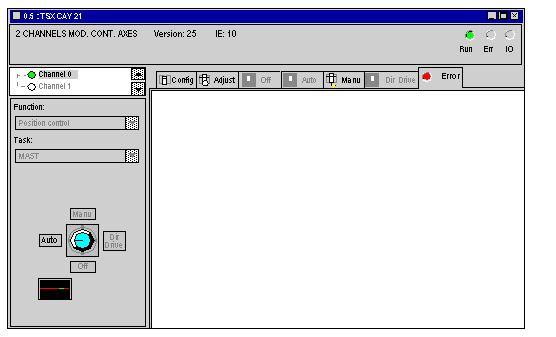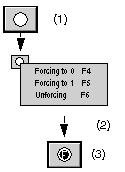|
Description of Debug Screens
|
|
|
(Original Document)
|

|
LED
|
State
|
Indication
|
|---|---|---|
|
RUN
|
Lit
|
Module in operation
|
|
ERR
|
Lit
Blinking
|
Module inoperative
Communication fault
|
|
I/O
|
Lit
|
External hardware fault (e.g. encoder, variable speed controller, outputs)
|
|
DIAG
|
Lit
|
Faulty module. On pressing the associated tab, a module diagnostics window will appear to indicate the source of the fault.
|
|
Command
|
Function
|
|---|---|
 |
Operating mode selector button.
If you wish to change operating mode, click on the name of the new mode to be selected (or click as many times as necessary on the button).
Using the keyboard, select the button with the Tab key, then press as many times as is necessary on the Space Bar.
It is also possible to access operating modes using the View menu.
When the selected mode is taken into account by the module, the movement monitoring zone for that mode is displayed.
Caution: Even though selected, the module channel may not take the mode into account (e.g. if the PLC is in STOP mode).
|
 |
Forcing command menu.
If an object can be forced, a right click on the corresponding button (1) displays a menu (2) which allows access to the forcing commands: Forcing to 0, Forcing to 1 or Unforcing.
After clicking on a command to select it, forcing is applied and the forcing status is indicated by the button (3):
The Global unforcing button in the module zone is used to unforce a set of forced objects.
|
 |
This zone displays a summary (with background on certain points similar to an oscilloscope) of the value of the analog output.
This value is between +10 V and –10 V.
|
|
CHi
|
Lit: Configured non-faulty axis (channel).
Blinking: Faulty axis.
Off: Non-configured axis.
|
|
DIAG
|
By pressing on the button associated with this LED, a dialog box appears, specifying the source of the fault.
|